In spring, you might find last year’s tomato plants coming back with new growth–surprise! Or, in early fall when temperature drops, those vibrant tomato vines will droop to the ground. Will they survive the winter & produce a second crop the following season? How long will tomato plants produce?
Tomatoes are tender perennials, but are grown as annuals by many gardeners. If protected from the frost, it’s possible for tomatoes to survive winter and produce a second crop in the next season. After the second year, the plants may still survive, but the yield typically drops substantially.
Though tomatoes can be grown as perennials, it’ll depend on your region’s climate and the kind of protection you offer. The 2nd year’s harvest might not be as impressive as the first one, but we’ll cover all that below.
Since you’ve got tomato plants, you should also check out our complete tips & tricks for growing more tomatoes.
How Long Will A Cherry Tomato Plant Produce?
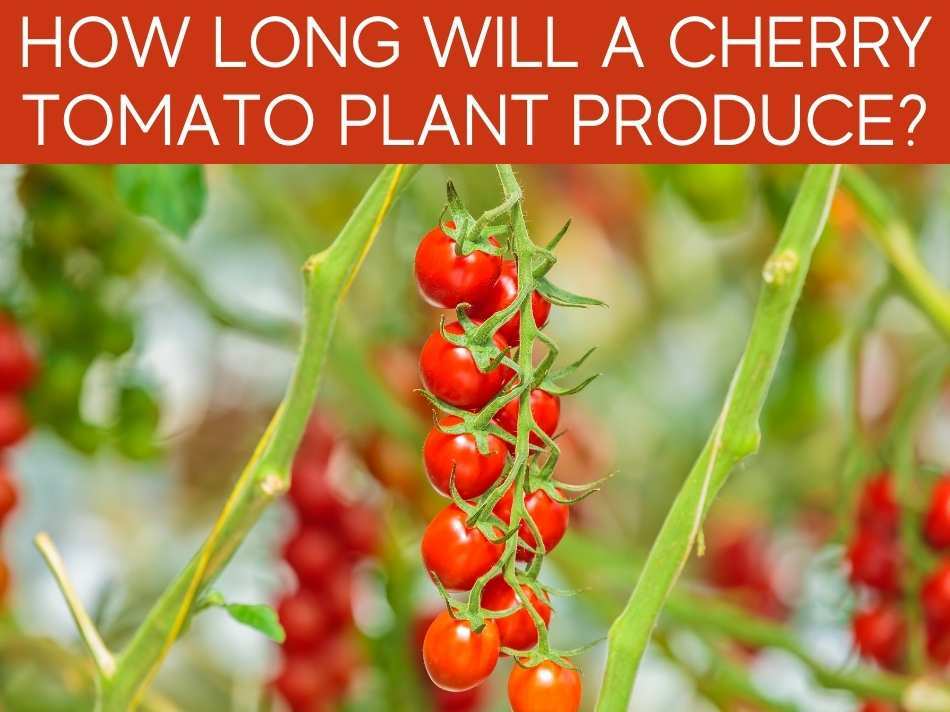
Cherry tomatoes are exceptionally simple to grow, & produce an abundant crop of tiny tomatoes at the end of the growing season.
They’re grown as an annual in most home gardens and take about 65 to 80 days to come to harvest.
There are both determinate and indeterminate varieties.
Cherry tomatoes come to harvest during late summers, usually between July and September.
While the fruits on determinate tomatoes ripen at the same time, indeterminate tomatoes continue producing until frost kills the plant.
Once the fruits start ripening, pick them each day to promote further production.
Harvesting your cherry tomato plants regularly encourages the plant to concentrate its energies on setting new blooms.
The blooms will eventually set fruit, resulting in several ripe tomatoes and extending your harvest.
Since they’re susceptible to frost, cherry tomatoes often survive through a single season only.
As soon as the days shorten and temperatures drop, even the indeterminate varieties stop flowering and fruiting.
At this point, the plants start losing their vigor.
As the first frost hits the garden in autumn or winter, tomato plants are the first plants to die in most summer vegetable gardens.
It is possible to overwinter cherry tomatoes if tropical temperatures are maintained all year round.
In fact, cherry tomato plants, and other varieties, are usually grown as perennials in the tropics.
In other regions, tomatoes can be grown as perennials by growing them in greenhouses or indoors.
The temperature will need to be regulated at the optimal range to keep them alive through the winter.
With warm temperature and enough light, you can trigger them to regrow and produce during the next growing season.
Let’s look deeper into the indoor growing of tomato plants in the next section.
How Long Will A Tomato Plant Produce Indoors?
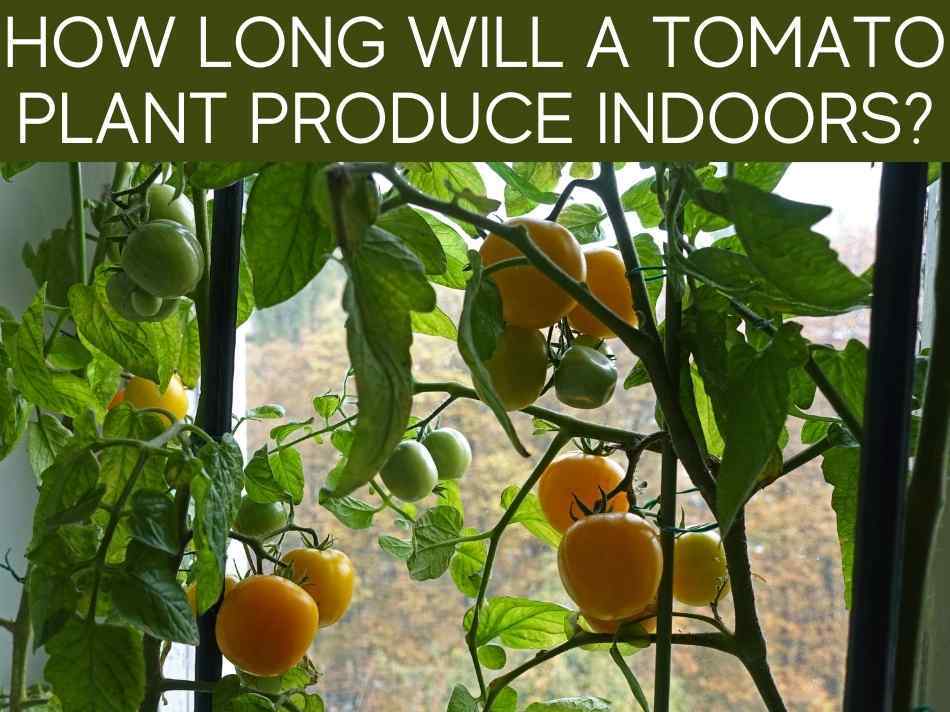
Since, theoretically, tomatoes are perennial plants, they have the potential to survive and produce past their first year–if conditions are right.
When growing outdoors, it’s hard to achieve the best conditions for tomatoes to survive year-round–especially in colder climates.
But it’s possible to overwinter it indoors or in greenhouses, as long as optimal temperatures are maintained.
Growing Tomatoes As Perennials Indoors
Although it’s not easy to overwinter tomatoes, there are multiple options you can try.
You can either grow tomatoes in a heated space or inside a greenhouse where consistent warm temperatures are maintained.
Alternatively, you can also grow your tomato plants in pots, taking them indoors as soon as cold weather approaches.
You should probably also check out our complete article for how to grow tomatoes in a greenhouse, if you’re growing indoors.
How Long Can Tomato Plants Produce Indoors?
When you grow them in a heated room inside your house or a greenhouse, make sure the temperatures don’t dip below 50°F.
With warmer temperatures, it’s possible for the tomato plants to live and produce for more than a year.
But how many years of growth and production should you expect?
It primarily depends on the environment and the level of care you offer these plants.
Since they’re tender perennials, with many limiting factors, including cold, pests, diseases, and nutrients, the number of years of viable production greatly varies between plants growing in different climates.
Often the plant begins wearing out past its second years of growth, and the yield begins to drop.
Typically, in 4 to 5 years, the plants exhaust all the nutrients from the soil, which in turn ceases tomato production.
However, if the optimal supply of nutrients is maintained, temperatures are ideal, and pests and diseases don’t attack them, the plants can continue growing and producing through the subsequent years.
Perennial Or Annual? What’s The Better Choice?
While it’s possible to grow tomatoes as perennials, from the above discussion, you might already have figured out why most gardeners choose to grow them as annuals.
Providing the best conditions to overwinter tomatoes to help them produce for multiple seasons is more of a hassle than planting new seeds each season.
After all, it only takes between 50 to 90 days for tomato plants to reach maturity once you plant a fresh set of seeds.
Not to mention the time and the resources you’ll be saving from not having to save your last year’s tomato plants from dying.
How Many Years Will A Tomato Plant Produce?
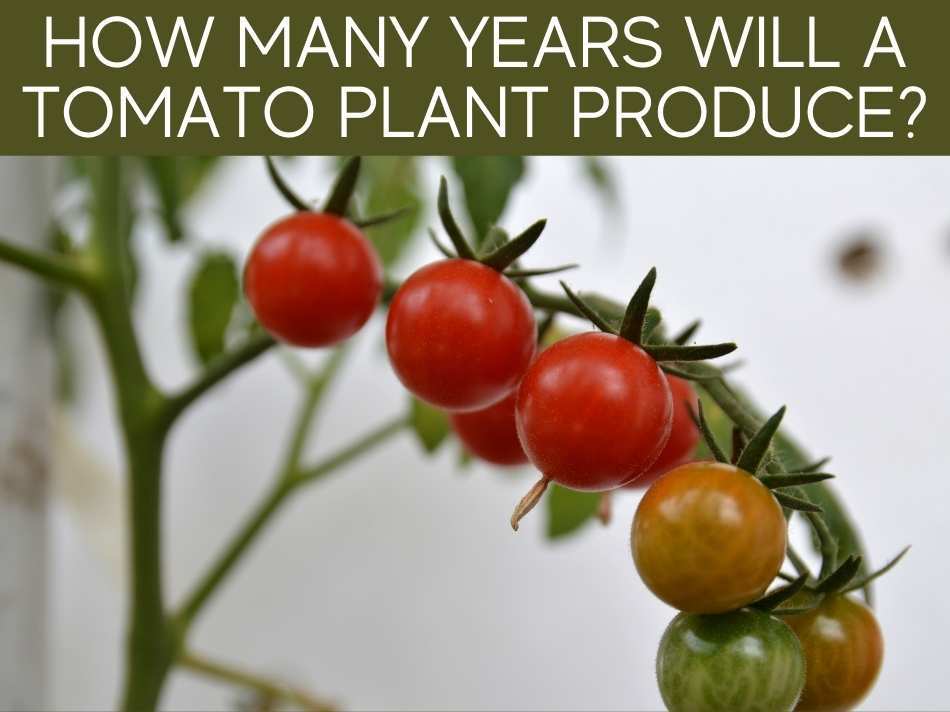
Generally, tomatoes are grown as annuals, allowed to grow, and produce for a single year only.
However, if given a chance, tomato plants can grow and produce fruit for more than one year.
However, there’s no exact answer to how many years a tomato plant will produce.
The number of years of growth of tomato plants will depend on the climatic conditions and the care it receives.
In tropical climates, tomatoes are short-lived perennials.
In tropical regions outside the continental US, such as Florida, tomato vines may survive and produce fruit for more than one year.
After the first two years of growth, tomato plants will start losing yield.
After 4 to 5 years of growth, if nutrients aren’t replenished in the soil, the fruit production might cease altogether.
Which Tomato Variety To Choose For Growing As A Perennial
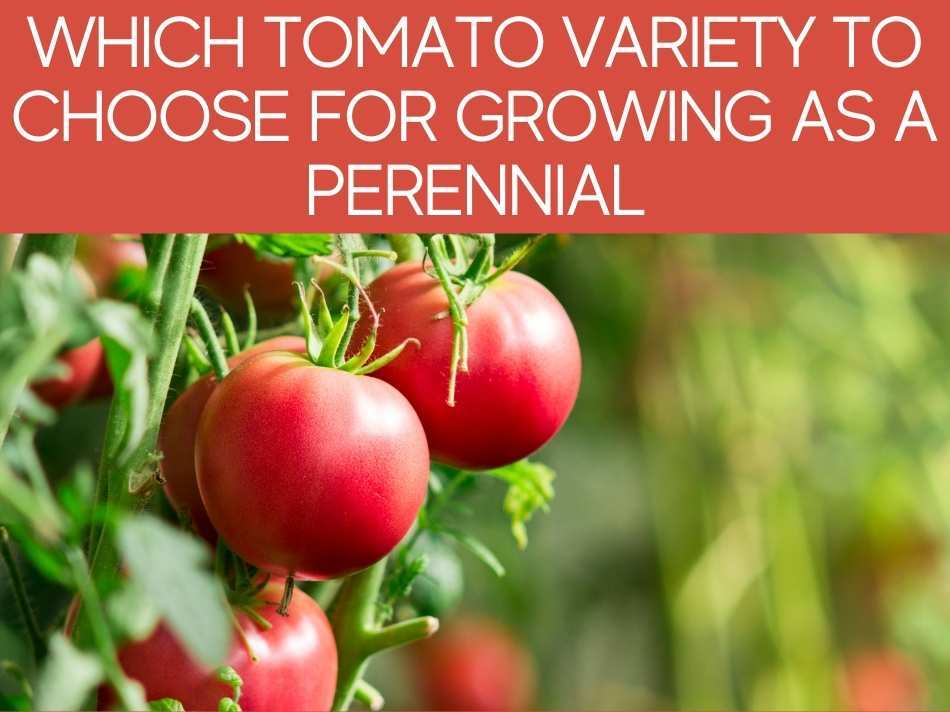
There are countless tomato varieties to grow in your annual summer garden.
However, if you’re hoping to grow the plants for multiple seasons, you’ll need to make your choice with care.
Generally, tomatoes that offer better resistance to cold, pests, and diseases are more likely to survive past the first year.
Other than that, between the two types, determinate and indeterminate tomatoes, indeterminate varieties are a better option for growing tomatoes as perennials.
Since indeterminate tomatoes continue blooming and fruiting until frost kills the plant, if you maintain the best condition for your crop, not letting the cold weather destroy it, these varieties can continue producing well beyond the harvest season.
Giant Tree Tomato At Walt Disney World
Gardeners who plan to save their tomato plants for multiple years can take some inspiration from the Giant Tree Tomato, Lycopersicon Esculentum, growing at Epcot Center in Walt Disney World, Orlando, Florida.
It established a world record by producing 32,000 tomatoes each year after 16 months of growth.
The tree has a short, thick, shrub-like stem, with support on the top to bear the weight of the abundant tomatoes.
Tomato Plants Growing From Last Year
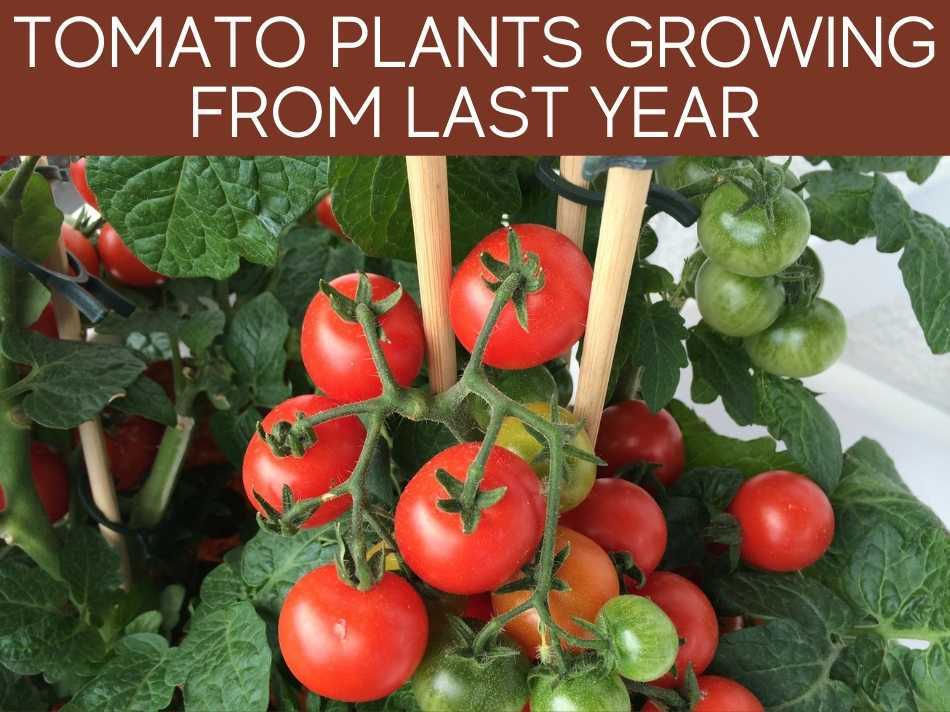
Have you ever seen a tiny, new tomato seedling sprout from the top of your compost pile or from the soil in the garden bed where you grew tomatoes last year?
You might be surprised to see fresh tomatoes growing out of nowhere, but it’s actually a common phenomenon called ‘volunteer’ tomatoes.
Volunteer tomatoes result from the germination of seeds from the original plant or a side shoot that survived the cleanup of the garden bed after last year’s harvest.
It can be tempting to let these volunteers grow and produce a second round of fresh tomatoes in the coming harvest season, but gardeners advise against it.
Because bacteria and fungi can multiply in the soil, infected plant debris, and volunteer plants, these spontaneous seedlings are highly susceptible to early blight and bacterial spot.
To protect your garden from diseases, it’s important to destroy weeds and volunteer tomatoes, and rotate crops.
The sooner you get rid of your volunteer tomatoes, the better.
Some of these plants can grow vigorously, taking over the space of the smaller crops that you might be growing in the same garden bed, such as carrots.
If they appear on your compost pile, they’ll make it difficult to access – not to mention all the nutrients they will eat up, possibly without giving viable fruit.
While there are risks, some gardeners don’t mind saving and nurturing the volunteer tomato seedlings that emerge in the warmer months, around June.
Move these seedlings to a separate pot so even if diseases do appear, they don’t infect your garden or the surrounding crops.
Seedlings that appear earlier, around April or May, are more likely to harbor early blight fungi, so they should be destroyed.
Do Tomatoes Regrow Every Year
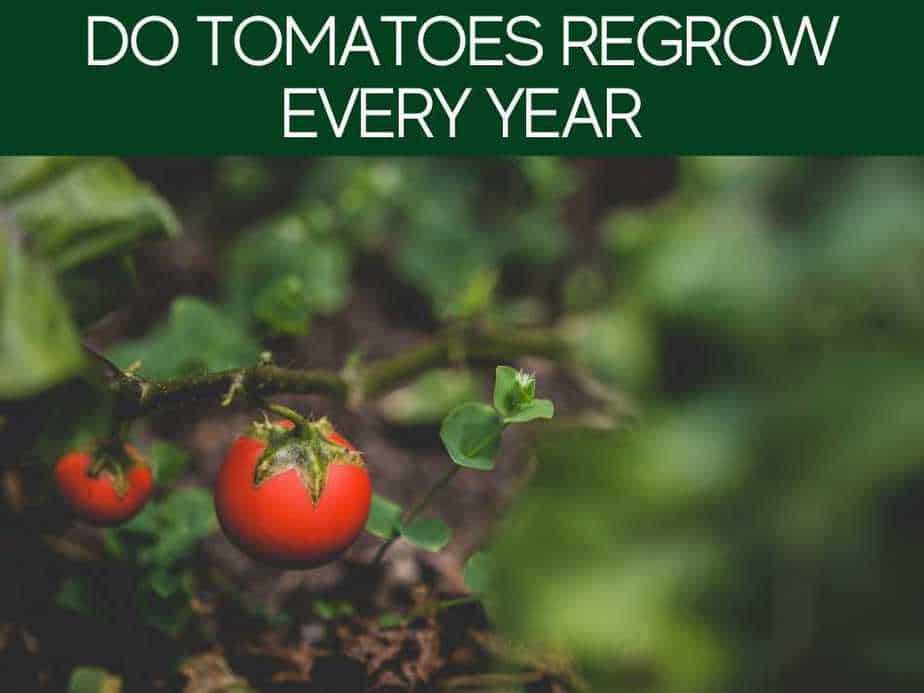
For tomato plants to regrow every year, you will have to live in a region where temperatures don’t drop below 50°F, or consistent warm temperatures will have to be maintained throughout the year.
In most climates, apart from some tropical regions, consistently warm temperatures aren’t a possibility.
Frost and freezing temperatures will easily kill these heat-loving plants.
If you’re growing in raised beds, you’ll want to plan for how far apart to plant tomatoes.
If you plan on growing tomatoes as perennials in a greenhouse, try experimenting with beefsteak, cherry, and grape tomato varieties since they’re hardy.
Plant them among your tropical plants.
Also, make sure you keep the area adequately heated when temperatures are low outside.
Plant tomatoes in pots and move them outdoors during the hottest days of summer to prevent them from overheating inside the greenhouse.
With the right care, you might just be able to pull out two or more years of viable harvest from the plants.
Alternative Approach – Propagate Suckers
Instead of helping the same tomato plant survive year after year, there’s an easier alternative.
Experienced tomato growers often like to get a head start on the coming season by propagating suckers from last year’s tomato plants.
Suckers are shoots that emerge from the point where a branch meets the stem.
Suckers pull energy from the plants that could otherwise be used for growing flowers and fruit.
So, remove suckers to boost tomato yield.
Instead of tossing the suckers into the compost pile, you can root them in water.
It’s actually pretty cool to watch them grow into a new round of tomato plants!
Plant the rooting suckers in a pot filled with fresh potting soil.
Then, move them indoors to a sunny window or place them inside a greenhouse before cold weather approaches.
Even if you aren’t able to provide the warm temperatures for them and the plants turn leggy, you can take new suckers from them and root them for a new round of seedlings.
Continue the cycle until the weather is suitable to allow the seedlings to grow into plants that will come to harvest by the end of summer.
You can probably get tomatoes ever earlier since you gave them a head start!
2nd Year Tomato Plant
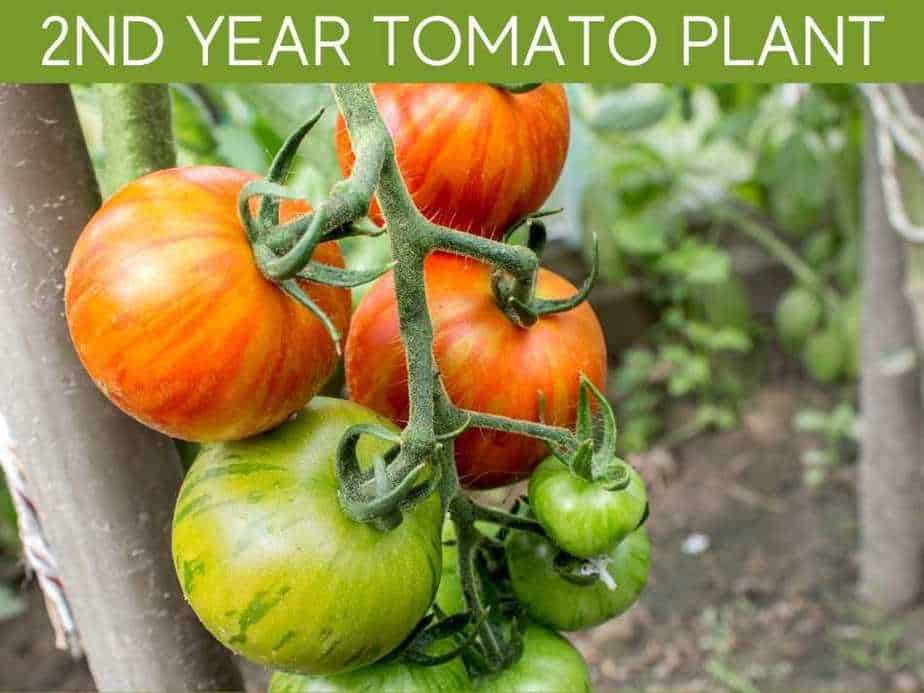
Since tomatoes can’t survive frost or freezing temperatures, they won’t survive outdoors in USDA zones lower than 10b.
However, in zones 10b and 11, tomato plants may survive for multiple years and produce fruit before finally ceasing production.
Growth of perennial tomatoes in warmer zones will halt during the winter months.
But as soon as the weather starts warming up in spring, you’ll see new shoots emerging from the branches.
A second-year tomato plant, or older, will require some care to continue producing with the same vigor as its first year.
Stake the branches to keep them drooping, pinch out the suckers, and prune out some foliage.
This allows the plants to focus their energies on the flowers and fruits.
With good care, you can expect a good yield from your two-year-old tomato plants.
But the yield will gradually decline over the coming years.
You’ll eventually have to replace them with new seedlings.
Perennial Alternatives For Tomatoes
If you’re not living in a tropical zone and don’t have the time or resources to spend on overwintering tomato plants in cooler zones, there are other alternatives you can grow.
Gardeners living in moderate or cold climates can grow the perennials from the list below.
Their fruits have a similar appearance and taste as that of tomatoes and can be used in much the same way:
- Goji berries (or wolfberries)
- Cape gooseberry (or goldenberry)
- Strawberry tomato (or husky cherry)
Can Tomato Plants Grow Year Round?
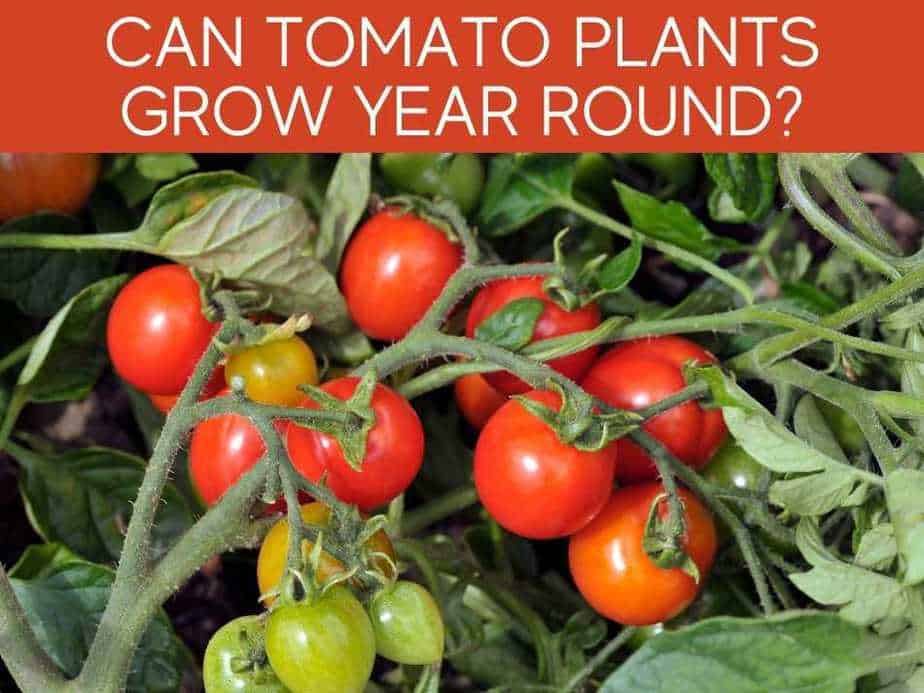
It’s not possible to grow tomatoes year round outdoors in moderate to cold regions since they can’t survive the winters.
If you want to extend the harvest season, you can plant them outdoors in pots.
Then, move them indoors near the end of the growing season as soon as cold weather approaches.
Since you’ve protected the plants from frost and freezing temperatures, the fruits will continue ripening.
And, you’ll benefit from a longer harvest period.
Eventually, the plant will stop producing fruit and the harvest season comes to an end.
A simpler way to enjoy fresh tomatoes all year round is to grow them indoors in containers.
With indoor tomato plants, there are no planting dates.
As long as suitable temperatures are available, you can plant successive crops every few weeks.
That way, you can enjoy a consistent supply of homegrown tomatoes all year long!
Do keep in mind that apart from the ripened fruit, the tomato plants are poisonous.
Keep the plants out of reach of your pets or children if you’re growing tomatoes indoors.
If you have rabbits, goats, or horses, you should also check out our specific articles on whether tomatoes are toxic for rabbits, for horses, and whether goats can each tomato plants.
Tips For Growing Tomatoes Indoors Year-Round
- Choose smaller tomato varieties, such as Tiny Tim, Terenzo, Lizzano, Early Wonder, or Bush Early Girl.
- For smaller varieties, 1-gallon pots are sufficient. For larger ones, however, pick 2 or 3-gallon containers.
- Use potting soil that includes peat moss.
- Choose a bright window, preferably a south or west-facing one. If ample lighting isn’t available, you can grow them under cool-white fluorescent lamps.
- Make sure they’re getting at least 8 hours of sunlight every day and aren’t sitting next to any draft windows. (You should also check out the full article on how much sun tomato seedlings need).
- Maintain temperatures between 75 and 85°F for best growth.
- Allow the soil to dry a bit on the surface before watering.
- Fertilize every two weeks with a balanced houseplant fertilizer.
Pollination Of Indoor Tomato Plants
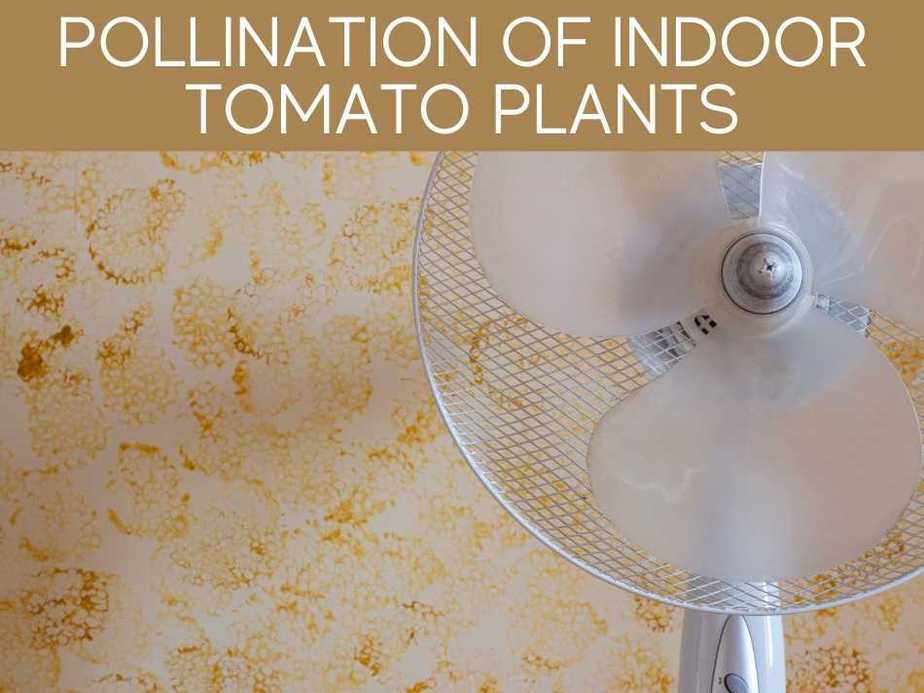
Tomatoes are self-fertile plants, and they don’t require much assistance from insects or gardeners to set fruit.
However, you can encourage pollination by placing an oscillating fan a little distance away from the plants.
Alternatively, you can gently shake the flowers to free pollens each time you walk past the plants.
Conclusion
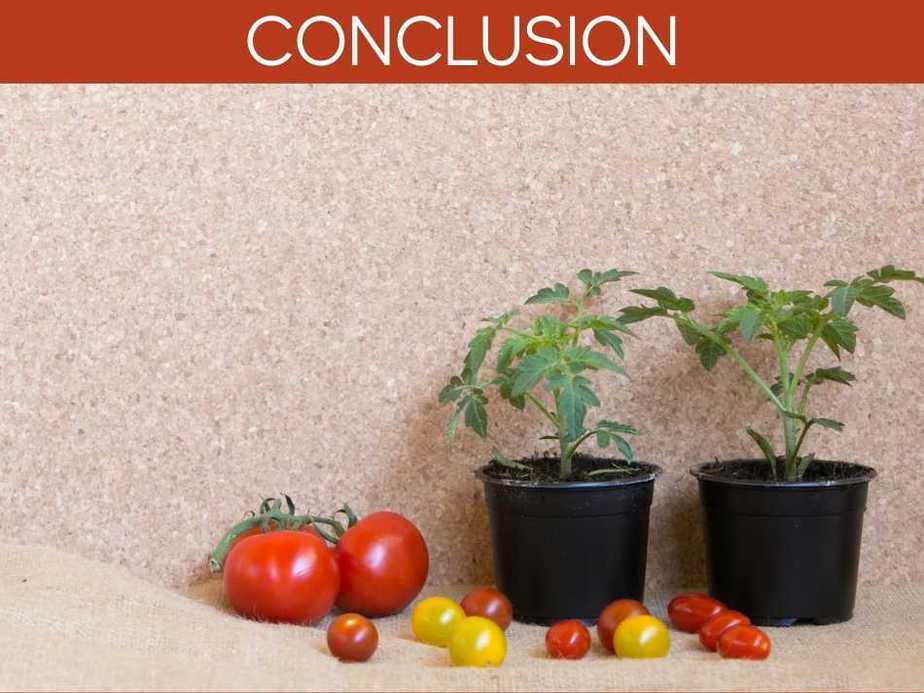
When you provide the best conditions and care, it’s possible that you can enjoy years of fresh tomatoes from the same plant.
Make sure they’re protected from the frost and have the best temperatures to thrive.
That way, they’ll return the favor with multiple harvests in the coming seasons.
